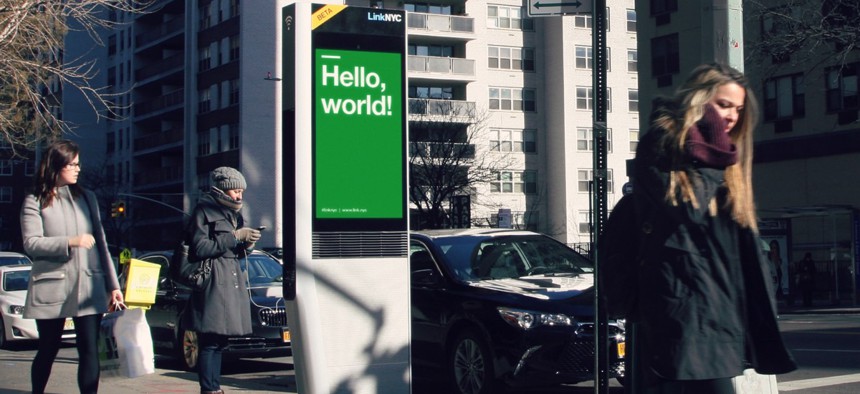5 Questions for the People Building the LinkNYC Kiosk Network

A LinkNYC wireless kiosk in New York City. Intersection
Intersection’s Chief Innovation Officer talks about working with Google’s Sidewalk Labs, introducing cities to disruptive tech, and upcoming transit and Internet of Things pilots in New York City and elsewhere.
Work on New York City’s free, gigabit-speed Wi-Fi network, LinkNYC, began in December with plans to replace 500 sidewalk payphones with smart kiosks by mid-summer on the way to 7,500 total.
Since Mayor Bill de Blasio promised the network in November 2014, the two companies on the project—Titan and Control Group—merged to become municipal media company Intersection. And that company quickly found a minority investor in Google’s New York City-based civic tech venture Sidewalk Labs.
Projected to generate more than $500 million in ad revenue over 12 years, the kiosks are expected to pay for themselves and then some.
Route Fifty caught up with Intersection’s Chief Innovation Officer Colin O’Donnell about the state of the transition and other planned pilots.
Dave Nyczepir: How is LinkNYC going?
Colin O’Donnell: In the first three months since we launched Wi-Fi on just a handful of kiosks, we’ve already served up over one million sessions. We now have a wireless network spanning 150 blocks from the East Village up through Harlem.
Thousands of people are registering every week, and we’ve gotten a ton of interest from cities around the world. LinkNYC’s ultra-fast Wi-Fi, digital platform and business model are resonating with people and administrations from all corners.
We’re in beta and getting great feedback from thousands of users all over the city through email and Twitter. We’re learning a lot and planning the next round of features. It’s been a super-positive, collaborative two-way conversation. We encourage people to send us ideas and suggestions, tell us what’s working and not through Twitter at @LinkNYC.
As we continue to expand the network across the city with thousands of links, we look forward to learning from our users and evolving the platform to make it work for everyone—from residents without home Internet access, to civic hackers who can design Link’s next applications, to tourists exploring the city, to advertisers that are ultimately funding the platform.
Nyczepir: What does being part of Google's Sidewalk Labs mean for Intersection?
O’Donnell: We’ve got a great relationship with Sidewalk; we share offices and collaborate pretty much every day. With its mission of improving life in cities around the world, we’re closely aligned and couldn’t have a better investor.
With Sidewalk’s deep ties throughout the Alphabet family, we have amazing access to world-class resources and thinkers across a stunning number of domains.
Nyczepir: What other projects does Intersection have in the works?
We have a team focused on scaling LinkNYC to all corners of New York City, building the best network in the world, and exploring ways to deliver hyper-relevant content across the city.
But we’re equally focused on building an amazing transit solution based off of all the work we’ve done on Link, overlaying a 21st-century experience over 20th-century infrastructure. Sidewalk has been a great partner in this effort, and we’re looking forward to rolling out some great joint products and projects over the next year.
Nyczepir: Back in 2014, New York City Hall had Titan remove beacons it installed from hundreds of payphone booths in Manhattan, after a BuzzFeed News article raised privacy concerns over their smartphone tracking ability and the lack of public discourse. What do you make of the devices and having to combat neo-Luddism—opposition to disruptive technology?
O’Donnell: We think you need to show people what can be done—what great experiences they can expect—when using a new technology.
It wasn’t too long ago that people thought GPS was a scary military technology. Now that people understand that they are in control and what a useful tool it is, people find they can’t live without it.
Location services technology, like GPS and beacons, are core to our mobile experiences—from finding yourself on a map to your phone knowing exactly where it is in a store and secure payments. Without GPS, apps like Google Maps and Uber could not exist. It’s hard to imagine life without those services now.
Beacons provide much better location services than GPS, especially indoors and in dense urban environments. Really well-integrated, user-controlled location services can unlock amazing experiences.
We’re really excited for the Physical Web—using our phones to browse physical space around us, discovering new things, just like we browse the Web. We see use cases that include helping the blind navigate the city, providing real-time transit information about the subway or bus stop you are standing at rather than the whole system, or serving information about historical and pop culture sites to tourists as they walk by.
On LinkNYC, Shazam used beacons as a way for people to discover the most popular music on their block. It has that fun and exciting feeling of discovery like when the Web was first getting popular.
Nyczepir: Are you working with any cities on Internet of Things projects, like a network to connect smart sensors?
O’Donnell: We look at the needs of the mobile Web in cities falling into two extremes:
- High-bandwidth, short-range applications like 4K movies, police body cameras, fixed camera-as-sensors providing analytics in the cloud, and other media-intense applications that can consume gigabytes of data an hour. These typically run over Wi-Fi and LTE and need big chunks of spectrum; and
- Low-power, long-range (LoRa) radios and applications that use tiny slices of spectrum and trickle data in on the order of a few kilobytes per day.
These networks are a bit like the Wild West—still yet to standardize—but we are working with some major partners and talking with a couple big cities to look at how we can bridge the two worlds with a common infrastructure and provide common data services for the billions of devices popping up all over cities. There is a huge opportunity space, and I think we’ll see some interesting pilots in the next year.
Dave Nyczepir is a News Editor at Government Executive’s Route Fifty.
NEXT STORY: Where a Wall Is Not Enough: Inside the Effort to Secure the Arizona Border






